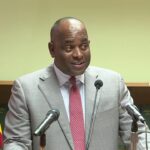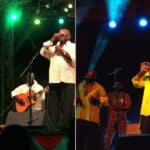PORT-OF-SPAIN, Trinidad, Wednesday April 24, 2013 – The history books have always indicated that the first inhabitants of the Caribbean were the Arawaks and Caribs.
But what those books have not indicated is that the indigenous people may have had strong ancestral links to Africa and to Native American Indians.
Recent work by the North American-based National Geographic Genographic Project on the Carib community in Trinidad, utilising Deoxyribo Nucleic Acid (DNA), has confirmed that members of the community in Arima have very strong ancestral links to Africa and to Native American Indians.
The project involved testing 25 members of the 600-strong Santa Rosa First Peoples Community in July last year and according to Ricardo Bharath-Hernandez, who heads the community, the results will hopefully put to rest the questions that have been raised regarding the community’s identity in the past.
The results of the project were released to Bharath-Hernandez late last month by Dr Jada BennTorres from the University of Pennsylvania.
In her letter, she thanked the Santa Rosa Karina community for its participation adding, “We have completed preliminary analysis of the mitochondrial DNA and Y-chromosome (NRY markers). These analyses will tell us about the maternal and paternal lineages of the community members.”
She said the findings of the genetic ancestry of the community “indicate a complex ancestry that includes Africans, in addition to a very strong Native American ancestral component” and that all of the 25 individuals tested would receive their information at a later date.
She has also promised to release detailed findings of the analyses to the community.
Dr BennTorres’ primary research area is the Anglophone Caribbean where she explores genetic ancestry and population history of African and Indigenous Caribbean peoples, according to her on-line profile.
A second area of her research “combines the tools and theories of molecular anthropology with molecular epidemiology in order to examine differences in the distribution of disease across human populations. This work focuses primarily on women’s health, more specifically on the prevalence of uterine fibroids among African Americans.”
Bharath-Hernandez said not all members of the community were enthusiastic about the project and hence the reason why only 25 provided swabs for testing.
The results have coincided with the discovery of pottery artefacts and bone fragments by workers doing restoration works at the parliament building last month. Officials believe that the discovery is a link to the Amerindian heritage dating back to AD 0-350.
Bharath-Hernandez, who has already visited the site, says he is prepared to perform the necessary ancestral rituals once it is confirmed that the fragments are indeed Amerindian.
He said the community is also excited to participate in yet another Genographic Project in an effort to trace the paternal and maternal lineages of all of its 600 members.
Bharath-Hernandez said he is also seeking to construct a permanent home for his community on 25 acres of land.
“We plan to construct a modern Indigenous Amerindian Village, meaning we want to keep the village as authentic and traditional as possible but with all modern day amenities.
“It will comprise a main centre to be used as a meeting and cultural space which will be located in the centre of the village. Spiritual rituals will also be conducted there. There will also be an official residence for the Carib Queen, Jennifer Cassar.”
Bharath-Hernandez said there are also plans for a cassava processing plant to make farine, cassava flour, cassava bread and casaripe; a craft centre where the people will be doing the indigenous craft, as well as an indigenous museum to display artefacts.
The plans also call for the construction of a guest house to accommodate visitors and students who wish to do ethnographic studies.
“The plan is to have 10 to 12 families living there permanently and they would be responsible for the management of the place. We are also going to have an agricultural focus, consisting of wildlife and crop farming.
“We intend to conduct eco-tours and nature trails, because the intention is to keep a major portion of land in its natural form,” Bharath-Hernandez said, noting the need for a natural watercourse though the land, which he said would have been possible, had the State granted them the 200 acres they requested.
“There is one on adjacent lands, west of the village, but that plot is privately owned and we may want to ask for that as well,” he said. Originally, he said the Amerindians were given 1300 acres of land.
“We have evidence that the Mission of Arima was established and the land was lost to the British but with the UN Declaration and Rights of Indigenous Peoples, one of the articles states that governments should work with indigenous communities to redress some of those wrongs.”
But he is grateful for the 25 acres despite the long wait.
“The journey took 40 years to reach here, starting with (former prime minister) Dr Eric Williams in the 1970’s, who, on a visit to Arima, was approached by then Queen Edith Martinez for assistance for the Santa Rosa festival. He instructed the Arima Corporation to give a grant of TT$200 (one TT dollar = US$0.16 cents) which was used to register the community.
“That grant moved to TT$500 and now stands at $5000 a grant. Successive governments over the years provided some assistance by way of small grants, but the idea of 200 acres of land was first discussed with the Basdeo Panday administration in 1995.”
Bharath-Hernandez recalled that in 1990, the then government approved a $30,000 yearly grant, but it was in 1995 when the community met with Panday to discuss a request for 200 acres.
“The idea is that most of the land would remain in its natural formation, because of importance of forest to the indigenous community, it would not be cleared for commercial use,” he said, indicating that while the 25 acres were awarded in December last year, the community does not have any official document in its possession.
“We have also not yet discussed under what terms the lands would be given; we are hoping it is not a lease arrangement but a grant in light of the fact that the community once owned 1300 acres.
“It has been a long process, about 40-plus years, [but] we are beginning to see some light at the end of the tunnel. It may not be finished in my lifetime but a major part would be established, “he said.
The community will on October 14 observe a Day of Recognition and the Carib Chief is hoping that with a permanent and spacious home, the community can do more to mark its heritage.(CMC)




